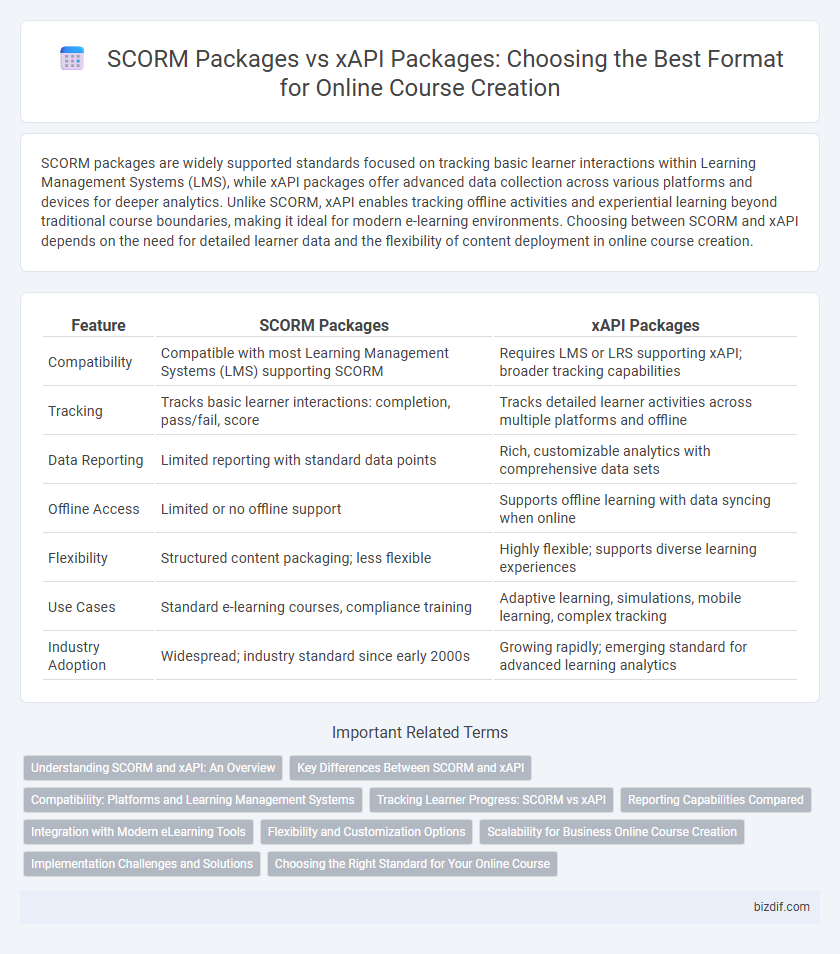SCORM packages are widely supported standards focused on tracking basic learner interactions within Learning Management Systems (LMS), while xAPI packages offer advanced data collection across various platforms and devices for deeper analytics. Unlike SCORM, xAPI enables tracking offline activities and experiential learning beyond traditional course boundaries, making it ideal for modern e-learning environments. Choosing between SCORM and xAPI depends on the need for detailed learner data and the flexibility of content deployment in online course creation.
Table of Comparison
| Feature | SCORM Packages | xAPI Packages |
|---|---|---|
| Compatibility | Compatible with most Learning Management Systems (LMS) supporting SCORM | Requires LMS or LRS supporting xAPI; broader tracking capabilities |
| Tracking | Tracks basic learner interactions: completion, pass/fail, score | Tracks detailed learner activities across multiple platforms and offline |
| Data Reporting | Limited reporting with standard data points | Rich, customizable analytics with comprehensive data sets |
| Offline Access | Limited or no offline support | Supports offline learning with data syncing when online |
| Flexibility | Structured content packaging; less flexible | Highly flexible; supports diverse learning experiences |
| Use Cases | Standard e-learning courses, compliance training | Adaptive learning, simulations, mobile learning, complex tracking |
| Industry Adoption | Widespread; industry standard since early 2000s | Growing rapidly; emerging standard for advanced learning analytics |
Understanding SCORM and xAPI: An Overview
SCORM packages standardize e-learning content for seamless integration with Learning Management Systems (LMS), focusing on tracking course completion and scores. xAPI packages enable detailed tracking of diverse learning experiences beyond the LMS, capturing data like learner interactions and performance across multiple platforms. Understanding SCORM and xAPI allows course creators to select the appropriate technology based on the complexity and analytics needs of their online courses.
Key Differences Between SCORM and xAPI
SCORM packages primarily track basic e-learning interactions such as course completions, pass/fail status, and time spent, while xAPI packages enable more detailed data collection including learner behaviors, offline activities, and real-world performance metrics. SCORM relies on browser-based learning management systems and requires a continuous internet connection, whereas xAPI supports data tracking across multiple platforms, devices, and even offline environments using a Learning Record Store (LRS). The flexibility of xAPI facilitates advanced analytics and personalized learning experiences, making it superior for modern, complex online course creation compared to the more restrictive SCORM standard.
Compatibility: Platforms and Learning Management Systems
SCORM packages maintain broad compatibility with most traditional Learning Management Systems (LMS), making them a reliable choice for standardized course delivery. xAPI packages offer enhanced flexibility, supporting a wider range of platforms including mobile apps, simulations, and virtual reality environments beyond conventional LMSs. Integration with modern learning platforms and analytics tools is native to xAPI, enabling detailed tracking of learner interactions across multiple devices and contexts.
Tracking Learner Progress: SCORM vs xAPI
SCORM packages track learner progress by recording completion status, pass/fail, and time spent within a Learning Management System (LMS) but are limited to online environments and predefined data points. xAPI packages enable comprehensive tracking across multiple platforms and devices, capturing detailed learning experiences such as interactions, context, and performance metrics in real-time. This enhanced tracking flexibility makes xAPI ideal for modern e-learning environments seeking deep analytics and seamless offline data synchronization.
Reporting Capabilities Compared
SCORM packages offer basic reporting by tracking course completion, time spent, and pass/fail status, relying heavily on Learning Management System (LMS) compatibility. xAPI packages provide advanced reporting capabilities, capturing detailed learner interactions, performance metrics, and offline activity across multiple platforms. This granular data collection enables comprehensive analytics and personalized learning experiences beyond traditional SCORM limitations.
Integration with Modern eLearning Tools
SCORM packages offer widespread compatibility with traditional Learning Management Systems (LMS), ensuring reliable tracking of course completions and quiz scores but often lack flexibility for detailed learner analytics. xAPI packages integrate seamlessly with modern eLearning tools and platforms, enabling granular tracking of diverse learner activities across multiple devices and environments. Enhanced interoperability of xAPI supports real-time data exchange and personalized learning experiences, making it the preferred choice for advanced training ecosystems.
Flexibility and Customization Options
SCORM packages offer standardized tracking but have limited flexibility in customization, restricting advanced data collection and interaction designs. xAPI packages provide extensive flexibility, enabling detailed learning experience tracking across multiple platforms and allowing custom data capture beyond traditional LMS constraints. This adaptability makes xAPI ideal for complex online course creation requiring tailored analytics and immersive learning paths.
Scalability for Business Online Course Creation
SCORM packages offer broad compatibility with traditional Learning Management Systems (LMS), but their scalability is often limited by rigid tracking capabilities and outdated data reporting standards. xAPI packages enable more scalable online course creation by capturing detailed learner interactions across multiple platforms and devices, allowing businesses to analyze comprehensive performance data in real-time. This adaptability supports scalable growth and personalized learning experiences vital for expanding enterprise training programs.
Implementation Challenges and Solutions
SCORM packages face implementation challenges such as limited tracking capabilities and rigid content structuring, often requiring LMS compatibility adjustments that increase development time. xAPI packages overcome these issues by enabling detailed learner activity tracking across multiple platforms, but implementation demands robust backend setup and data security measures. Solutions include adopting LMSs supporting xAPI, deploying middleware to facilitate data exchange, and thorough testing to ensure smooth package integration and accurate data capture.
Choosing the Right Standard for Your Online Course
SCORM packages offer broad compatibility and are well-suited for traditional Learning Management Systems (LMS), ensuring reliable tracking of learner progress and completion status. xAPI packages provide enhanced flexibility by capturing diverse learning experiences across multiple platforms, including mobile apps and offline environments, which supports advanced analytics and personalized learning paths. Selecting between SCORM and xAPI depends on your course delivery goals, tracking needs, and the complexity of learner interactions you want to monitor.
SCORM packages vs xAPI packages Infographic

 bizdif.com
bizdif.com